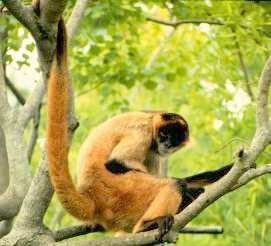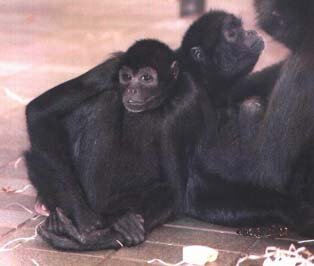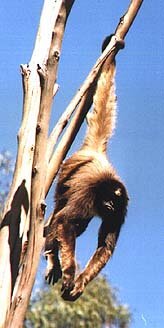SPIDER MONKEY FACTS

| Family: Cebidae |
Subfamily:Atelinae |
| Genus:Ateles (Originally called "Simia" by Linnaeus, 1758) |
Species: six (disputed) -- |
- belzebuth (white-bellied or long-haired spider monkey) - Geoffroy, 1806
- chamek (black-faced black spider monkey) - Humboldt, 1812 - separated from paniscus by Groves, 1989
- fusciceps (black-headed or brown-headed spider monkey) - Gray, 1866
- geoffroyi (black-handed spider monkey) - Kuhl, 1820
- marginatus (white-whiskerd spider monkey) - Geoffroy, 1809 - separated from belzebuth by Groves, 1989
- paniscus (black or red-faced spider monkey) - Linnaeus, 1758
-
Several subspecies have been identified.
Appearance:
Appearance varies with species, and sometimes within species. All spider monkeys are extremely specialized for a highly mobile arboreal lifestyle. They are long-armed and long-legged with a slender body, small head with substantial muzzle, prominent abdomen, and a highly usefull prehensile tail, which is longer than its combined head and body length, and functions as a fifth limb. The underside of the tail is naked and ridged like a fingerprint for added grip. It is said that even the tip of their tail can support their entire body weight. Spider monkeys have been called "the supreme acrobat of the forest" (Baker, 1997). They have either no thumbs, or useless rudimentary ones, but great finger prehensibility, which is said to be an adaptation associated with semi-brachiation. They can pick up things with their tails, which are capable of "precise and agile movements" (Robinson and Janson, 1987). Seven neck vertebrae are elongated to produce a more flexible neck, and they have a variable number of back vertebrae (17-20). They generally weigh from 13-25lbs., and are about 19-20ins. in length, sometimes longer. Females tend to be a bit larger and heavier than males and they have an enlarged clitoris which resembles a penis.
Range and Diet:
Spider monkeys are generally found in lowland rain forests from Mexico to South America, along the coasts and the banks of the Amazon, and the mountain forest slopes of the Andes. They are restricted to arboreal habitats, mainly in the top of the tree canopy. The range size varies. Their mean day range is generally longer than other NW monkeys, because of their reliance on fruit. Groups defend their ranges. Males will mark their territory with secretions from chest glands. Anyone stumbling into spider monkey territory receives an unpleasant ‘welcome’ of screams, barks, and rattling branches and thrown branches or feces. The interactions will often begin with males, often along with one or two females, calling, which will bring other group members into the area. The outcome of conflict is site dependent. One group will displace another in the more central regions of their range. Range overlap between different groups of the same species will vary with population density and home range size.
The exact composition of their diet varies with species and location. They generally specialize in ripe fruit, which makes up over 80% of their diet. This is supplemented mainly with flowers and leaves. They can also make use of seeds, nuts, insects, and eggs. Spider monkeys adopt strategy of seasonal movement within their large range to exploit seasonally fruiting trees. A. geoffroyi have been seen to open unripe fruit while it hangs on the vine, which accelerates its ripening. Other clever foraging techniques have included raiding the dining hall of primatologists to survive during a particularly poor fruit season, while other species of monkeys and mammals starved to death (Jolly, 1985).
Behavior and Social Structure:
Spider monkey society is normally multimale and multifemale, though some smaller groups may only have a single male. Females generally outnumber males two to one, and there are fewer young than adults (about 30% of total group), due to a low reproductive rate. Social grouping is fluid and said to resemble that of chimpanzees, a primate group that also favors ripe fruit. Though they are the most solitary of primates during daily food foraging, at night they are highly social and are said to "bed down in heaps" (Baker, 1997).
 Group size varies with the species and location, and reports of these vary. These generally range from 10-40, though groups as large as 100 individuals have been reported. These will break up into subgroups of varying composition, which move independently of one another to forage in the same general area. The entire group is only together a few weeks out of the year.
Group size varies with the species and location, and reports of these vary. These generally range from 10-40, though groups as large as 100 individuals have been reported. These will break up into subgroups of varying composition, which move independently of one another to forage in the same general area. The entire group is only together a few weeks out of the year.
Subgroup composition is variable and temporary. They are larger in the months when resources are more plentiful. The most frequent group is an adult male, adult female, and her dependent offspring, though males are said to “stay aloof” from females (Baker, 1997) during daily travel.
In-group aggression is rare, but it is said that adult males can be “clearly ranked” (Robinson and Janson, 1987), usually age-graded. Females also have dominance hierarchies. Males, though outnumbered and outweighed, are dominant to females and more aggressive. Males form coalitions against the larger females. Females coalitions have not been observed. Male groups will attack male outsiders. The entire sub-group will threaten interlopers with intense visual and vocal displays, which include loud vocalizations, rattling branches, throwing objects, like branches or feces, and urinating on intruders. They seem to be rather xenophobic, especially towards humans, and with good reason.
Grooming is most often observed between mothers and offspring. Adult males and females with dependent offspring groom more than juveniles and females without offspring, and give more than they receive. When separated, group members will communicate with a sound similar to a whinny. They have a variety of vocalizations, and they also scent mark and urine mark.
Spider monkeys will often share their habitat with other diurnal monkey species. They normally manage to avoid each other by having different patterns of movement and foraging. However, spider monkeys have been known to harass howlers, and sometimes kidnap their babies. They have also been seen fighting capuchins.
Reproduction and Lifespan:
Spider monkeys are non-seasonal breeders. The estrus cycle is 24-27 days with mating restricted to 3-4 days; gestation length reports vary from 139-230 days, with the longer interval the most frequently reported. Females actively choose their mates and initiate copulation, sometimes preferring to spend the entire mating period with one male, at other times mating with several males in one day. Males normally don’t fight for mates and there is no clear relation between rank and reproductive success. Females give birth to single infant every 2-4 years. Infants are normally dependent for 3 years and reach sexually maturity at age 4 for females and age 5 for males. Females migrate to other groups more often than males. Their lifespan in captivity ranges from 30-40 years. All of this varies somewhat with the species.
Conservation Status:
Three of the spider monkey species, the white-bellied spider monkey, brown-headed spider monkey, and white- whiskered spider monkey are listed as Endangered by either USESA or IUCN. This means that these species have at least a 20% chance of going extinct in the wild within 20 years or 5 of their generations. The black-handed and black spider monkeys are listed as Vulnerable by IUCN - there is at least a 10% probability of extinction within 100 years. Only the black-faced black spider monkey is considered at Lower Risk (CITES II.)
Spider monkeys are hunted for food and their habitat is disappearing. There is also a lucrative pet trade. In one report by the International Primate Protection League dated June 22, 1995, 29 baby spider monkeys were confiscated in Mexico, ranging in age from 20 days to 5 months. Their large group numbers and noisy habits reportedly make spider monkeys very easy to find.
 Interesting Spider Monkey Facts:
Interesting Spider Monkey Facts:
Spider monkeys are among the most agile of the primates, able to access fruit wherever it grows — even on terminal branches. Their ability to move with precision and ease throughout the forest canopy is probably where their common name stems from.
Research by Milton (1993) comparing spider monkeys and howlers found spider monkeys seemed to behave “smarter.” Their brain was found to weigh twice that of howlers, though the animals were roughly the same size. Milton attributed this difference to diet. The larger brain of the spider monkeys would aid in searching for and remembering locations of their rarer food source and in dealing with their more complex social system related to their foraging patterns. Found correlating data in published reports of the brain sizes of other primates — those that eat higher-quality, more widely dispersed foods generally have larger brains than similar-sized primates that feed on lower-quality, more uniformly distributed resources.
Aiello and Wheeler (1995) expanded this into their “Expensive Tissue Hypothesis,” which states that the metabolic requirements of relatively large brains are offset by a corresponding reduction of the gut, and dependence on high-quality, easy-to-digest food.
White-bellied spider monkeys eat the decaying wood and mud used by termites to build a tree nest, but they do not eat the termites. Why they eat wood is currently a mystery.
Current Research with Spider Monkeys:
(Note: The following are examples of recent research done with these primates, it is by no means an exhaustive list. This list will be periodically updated as more information becomes available. Also, though Mindy's Memory Primate Sanctuary DOES NOT support invasive medical research on primates, some articles of this type will be listed - both for information and as examples of the work that is currently being done with these animals.)
Aiello, L C
Brains and guts in human evolution: The expensive tissue hypothesis. BRAZILIAN JOURNAL OF GENETICS 20(1): 141-148, 1997.
Anaya-Heuertas C; Mondragon-Ceballos R
Social behavior of black-handed spider monkeys (Ateles geoffroyi) reared as home pets. INTERNATIONAL JOURNAL OF PRIMATOLOGY 19(4): 767-784, 1998.
Campbell CJ
Fur rubbing behavior in free-ranging black handed spider monkeys (Ateles geoffroyi) in Panama. AMERICAN JOURNAL OF PRIMATOLOGY 49(1): 40, 1999. (Abstract)
Durlot S; Gay P
1997 European Regional Studbook for the Spider Monkeys Ateles ssp. and an EEP for Ateles fusciceps robustus. NEOTROPICAL PRIMATES 7(1): 26, 1999.
Kinzey, W G
Synopsis of New World primates: Ateles. Pp. 192-199 in NEW WORLD PRIMATES: ECOLOGY, EVOLUTION, AND BEHAVIOR. W.G. Kinzey, ed. New York, Aldine de Gruyter, 1997.
Long, J A; Lamberski, N; Shoemaker, A H
Ejaculate characteristics of the black-handed spider, southern black howler and Diana monkey. JOURNAL OF ANDROLOGY (Suppl): P41, 1997. (Abstracts)
Matisoo-Smith, E; Watt, S L; Allen, J S; Lambert, D M
Genetic relatedness and alloparental behaviour in a captive group of spider monkeys (Ateles geoffroyi). FOLIA PRIMATOLOGICA 68(1): 26-30, 1997.
Newland K
1997 NORTH AMERICAN REGIONAL (HISTORICAL) STUDBOOK FOR SOUTH AMERICAN SPIDER MONKEYS, ATELES BELZEBUTH, A. FUSCICEPS, A. PANISCUS--ALL SUBSPECIES. Memphis, Memphis Zoo & Aquarium, 1999, 146 pp.. (Data through 12/31/97)
Newland K
South American Ateles regional studbook for North America: 1997. NEOTROPICAL PRIMATES 7(1): 26-27, 1999.
Newland, K
NORTH AMERICAN REGIONAL STUDBOOK FOR SOUTH AMERICAN SPIDER MONKEYS, ATELES BELZEBUTH, A. FUSCICEPS, A. PANISCUS--ALL SUBSPECIES: 1996 UPDATE. Wichita, Sedgwick County Zoo, 1997, 43 pp. (Data through 12/31/96)
Pastor-Nieto R
Familiarity and co-operation in spider monkeys: Coping with group living in capacity. PRIMATE EYE (64): 23, 1998.
Pingry, K
Studbook for the Central American spider monkey, Ateles geoffroyi. NEOTROPICAL PRIMATES 5(1): 13, 1997.
Strier KB
The Atelines. Pp. 109-114 in THE NONHUMAN PRIMATES. Dolhinow P, ed. Mountain View, Mayfield Publ, 1999.
Watt, S.
Alloparental behaviour in Auckland Zoo spider monkeys Ateles geoffroyi. AUSTRALIAN PRIMATOLOGY 11(2): 6, 1997.
References:
Baker C (1997) Costa Rica Handbook. See Webpages: Mammals.
Jolly A (1985) Primate Behavior. New York: Macmillan Publishing Company.
Milton K (1993) Diet and primate evolution. Scientific American August 269(2):86-93.
Primate Information Center. , Manager. . Washington Regional Primate Research Center and the Health Sciences Libraries. University of Washington, Seattle
Robinson JG and Janson CH (1987) Capuchins, squirrrel monkeys, and atelines: Socioecological convergence with old world primates. In Smuts BB, Cheney DL, Seyfarth RM, Wrangham RW, and Struhsaker TT (eds.) Primate Societies. Chicago: University of Chicago Press. pp.69- 82.
Rowe N (1996) The Pictorial Guide to the Living Primates. East Hampton: Pogonias Press
Sleeper B (1997) Primates. San Francisco: Chronicle Books
Webpages:
Ateles
Ateles geoffroyi
Mammals
